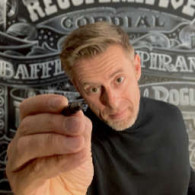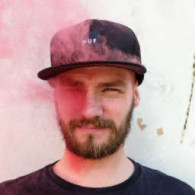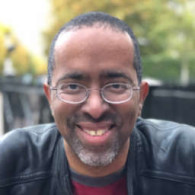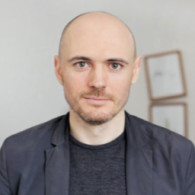Transcription
[Music]
[Audience applause]
Eva-Lotta Lamm: All right. Hi. For some weird reason, I’m slightly nervous. I don’t know.
Who of you has got a pen and some paper with you in this room?
All right. Great. You should get it out because we are going to draw together today. I’m going to explain a few things, and it’s always more fun if you draw along. So, if you don’t have a pen and the person next to you has got two, you know who to ask.
I’m going to tell you a little bit about myself in the context of drawing. While you get out your pens, my name is Eva-Lotta, as Marc already said. I draw stuff. I sometimes draw sketch notes at conferences like at Beyond Tellerrand. That was three years ago now, so my sketch notes look like this.
These look pretty neat. They are done digitally. But nevertheless, they are done live, so I listen and draw at the same time. That means I have to be pretty quick with drawing because otherwise, the page stays empty.
But of course, not all of my drawings are that neat. Many of my drawings look like that. They are pretty messy and quick. I love drawing while I explain things.
I like drawing to understand complicated things like the voting system in Germany, for example, that has lots of moving parts, and understanding how it all comes together. Sometimes it’s easier to just map it out.
Very often, I draw with other people to figure out scenarios or figure out products and systems and services, especially things that have a lot of moving parts where you want to see the relationships and maybe can’t keep everything in your head at the same time.
It often looks like this. I draw with and for other people. Very often, when I start drawing, I have no idea what I’m going to draw because it is a process of actually building knowledge while you talk and work and draw.
The drawings are not very elaborate. They are actually fairly simple, but they are quick and they help to kind of orientate yourself on the page and actually illustrate some of that stuff and give a spatial representation of the knowledge or the discussion that we are having.
With that, I am actually going to switch to this thing. Let me do this and get rid of that, the mouse.
This is live. This is my hand. I brought some pens, which brings me to this way of drawing that I do.
I like to call it pragmatic sketching because when I say I draw, then people think I’m an artist. Of course, I’m happy when things turn out to look nice. That’s always a bonus. That’s the cherry on top of the icing on top of the cake.
But we first need a good cake, and a cake usually is pragmatic, right? It tastes good and it makes your belly full.
Pragmatic sketching, I like the word pragmatic because it actually inherently has something built in. I’m just going to underline that.
That is pragmatic implies that it’s always for a purpose. If I wanted to anchor the word purpose, maybe I draw a little shooting star. That’s kind of my purpose or my guiding star. I don’t know, but it’s not just for prettiness sake. Although, prettiness is valued.
When do I sketch? What is the purpose for sketching? Well, if this is me, I often sketch -- I start sketching when I need to think about something and think something threw because the sketching actually helps me to not having to keep everything in my head. I have a really bad memory, and I find it easier to have help on a piece of paper.
Once I thought something through, of course, I cannot only think about it but I can also start to explain it to people. I find it extremely helpful to be able to also draw and put things on a page so that people don’t have to remember everything I said, but it’s also on the page, like as a shared memory for a group.
When working with a group, very often it’s not just one-way communication, but actually, we can also use sketching to actually develop ideas. You know? Iterate on them. I am sure you are iterating a lot in your job if you are in design or in coding or in product management. So, you can also use sketching to actually do iterations fairly fast.
These are three really good purposes that I use sketching for. I want to get to the sketching part of pragmatic, so this is kind of the pragmatic part, but the sketching part is interesting as well.
I’ve been thinking about sketching quite a lot on the meta-level, and what it breaks down to, for me, is actually that sketching is making -- it’s a set of choices or a set of decisions that I make. While I’m sketching, I’m asking myself a lot of questions like:
What do I want to draw?
How big do I draw it?
Where do I put it on the page?
How thick should be the strokes?
Should I put it in color?
What is the shape?
All these kinds of choices or decisions that I make, they actually can also help me to ask good questions about the thing that I draw because I have to make these choices.
I need to know what is the thing. is it important? Do I have to put it in the middle, or is it just a side thing? Or does it have to kind of--? Is it the first thing that you need to see? Maybe I need to have to highlight it and color and all these kinds of things.
Of course, for getting better at sketching, it is good to get better at making these informed choices. Making better choices usually leads to you being a better sketcher, like making good choices about your frameworks and about your variables and all these things makes you a better developer as well. There are certain principles, and the same is true for drawing.
Why do we draw? Why this sketching? Well, usually, one advantage of sketching is, we say, because it’s quick. Well, it’s quick because I don’t have to fire up a computer. I don’t need any tools. But also, it’s a relatively quick way of visualizing things.
Now there is Midjourney and AI things, but I mean you have to do a lot of rounds of prompting to get a good picture out of Midjourney. It’s an art in itself. We’ll see how it develops.
I’ll just make my own picture, so my prompt is quick. I pretend I’m Midjourney now, so I just make it. I anchored with a little rabbit, like making two ears on my rabbit because rabbits are quick. Then you have a half circle and another half circle. Then you have a leg and a belly and the leg and the back leg and maybe a second back leg and a front leg and a little cloud as a fluffy tail. So, this is quick.
But on the other hand, our sketches should also be clear because the whole purpose why I’m actually drawing is because I want to bring clarity to the discussion or to the thinking or to the explanation that I give. I’m going to anchor my--
I like to anchor all my key concepts with icons because then it’s easier to kind of scan the page and find the concepts if you don’t have to read everything. That’s a little trick that I’m using here.
I like the visual of a diamond for clarity because you can look through it and then also the light is refracted and you can see all the colors in the light. It gives you more clarity to what light is actually made of - blah, blah, blah.
This is basically [laughter] a triangle on the tip and then one, two, three triangles across the top. And then you close it. And then you connect these two points with the bottom and... ta-da! These lines, by the way, are the visual representation of ta-da. So, if you want to make something special, you just put these kind of little circular lines around it and it’s much better than before.
This is -- we also want to make it clear and, sometimes, these seem to be kind of at a--
They seem to be competing with each other, you know? Because when you make things quick, sometimes they get less clear. But we want to get to kind of a harmonious relationship. We want to make things quick and clear.
How do we make things quicker? Well, we don’t make our sketches quicker by moving our hand faster across the page because, usually, like when you’re starting to talk really fast and blah-blah-blah-blah, it gets really muddled.
What you want to do is actually the trick. How you get quicker is actually remember sketching is a series of choices. So, you need to make faster choices. Because usually, the thing that takes time when you’re drawing things, it’s not the moving of the hand. It’s actually thinking about how you want to do it and what you put on there.
When we can make our choices faster, then our drawing gets faster. Usually -- I have to disappoint you -- that comes with experience, which also means it comes with practice. Like everything you want to do well, it’s not just you do a two-hour workshop and then ta-da, you have these lines around, and you can do it. Nope.
But also, there are some patterns and some principles that you can apply and at least apply also in your practice that give you a jumpstart like when you learn how to write. The teacher gives you some hints of how to do it, how to construct the letters, and how the principles and patterns work of putting letters together and putting words together.
We’ll dive into some of those so that you have a head start and can start practicing. Then, of course, on the other side with the clarity, how do you get clearer?
Well, it’s not about faster choices, but I would say it’s about making better choices. The choices that actually make an impact, that make your drawing clearer so that you can actually see what’s going on, like applying visual hierarchy and making shapes in the way that they are recognizable.
Very often, also, being clear is actually about like good writing, like in good coding. What I’m saying here can actually be applied to life in general. So, if you’re not into sketching, I think you can transfer some of that to other areas in your life.
It’s basically making better choices. It’s about getting to the essence. What is the really important thing? You know? What is the thing that you want to say? What can you leave out? What is all the waffle that you can just throw in the bin straightaway that you don’t have to wade through?
This, in a nutshell, is kind of my philosophy of why I draw and how I try to draw, and also how I try to teach this to people because I think that drawing is (in German, you would say) -- now I forgot the German word.
Well, basically, it’s [laughter]...
Oh, my word. I’m really nervous.
Sketching is basically, for me, like a basic cultural skill that you should have, like writing, for example. It really gives you another layer to express yourself, and it shouldn’t stand in the odd corner. If you have talent for art, it’s like, oh, now you draw.
Imagine if--
Learning to write is not that easy. Maybe you remember when you first went to school and tried to learn to write. It was quite difficult. It took some time.
But imagine if we did the same with writing that we do to drawing and say, “Oh, you don’t seem to have talent for writing. Well, not necessary. You can -- I don’t know -- become a YouTuber or something.”
YouTubers are great as well, but when a YouTuber can write, it makes it easier for him to plan his content, actually. So, whatever.
[Audience laughs]
Eva-Lotta: I think this little bit of a hump that you have to go over is really worth it because, afterwards, you can apply it to so many things in your life and you will benefit.
All right, so let’s move on to one of the things that I mentioned. I want to say something about clarity because clarity is one of my favorite subjects, and it’s basically the whole reason why I do what I do. So, I write clarity here.
By the way, this is already the part where you can draw along because, if you draw along, you will have a set of lovely notes that you can review later after the talk (if you’re interested in this). You are invited.
Clarity, I said I will anchor that with my little icon again - ding-ding-ding-ding. I already know how to draw a diamond. Ta-da! It’s good. Repetition is good. Repetition is practice.
In my opinion, in my empirical opinion over the last 15 years thinking about it and teaching it to people, this is not scientifically proven. This just comes from my own head and experience. There are kind of three elements to clarity in sketching, in talking, and in writing.
I don’t know. Again, it applies to life.
The first layer of clarity I like to call formal clarity. It relates to the form, and that means that the shapes that we draw are actually legible as the shapes that they are.
When I want to draw a square or rectangle that I can see, oh, it has four corners. It seems to be a square. But sometimes, especially when time pressure comes in and you want to get faster, sometimes this happens. You know?
It’s like, “Ah, yeah. I want to do this.” Then all of a sudden it’s like, “Is that a J that has fallen over, or is that a stone? I don’t know... A potato?” Who knows?
This is the really basic level, and this is a lot about--
I like to call this clear articulation. It’s a little bit like speaking. In this case, clear articulation of the line because the line is the medium that we use when we draw.
If somebody gives a talk and they’re not articulating their words, but they are mumbling, it’s really hard. It can be a great talk. But if you can’t understand the words that are coming out of their mouth, it’s hard to listen and hard to understand. The same is true with our drawing.
The other thing is also what helps in public speaking (but also in drawing) is calm and confident. In speaking, it would be voice or way of speaking. For us, of course, it’s a line or also line quality.
The calm and more confident it stands on the page, the easier it is for the person to look at it. Yeah?
This has a lot to do with -- dupe-dupe-dupe -- this is a hand. [Laughter] You can see maybe it’s a glove, but it’s supposed to be a hand. This has a lot to do with our motor skills. How do we move the hand around the page?
We are not writing a lot by hand anymore so, for some people, it’s actually difficult to acquire these subtle motor skills in the beginning, and it can even hurt in the beginning to do that. It can be quite exhausting. But this is something that we can practice.
I often talk about choreographies when I talk about drawing. The order in which I draw things, it’s a little bit like dancing. The first time you want to do the [singing] “All the single ladies, all the single ladies.”
It’s hard. You have to think about it. When you did it 100 times, boom, it just flows out. The same is true with drawing anything. If it’s diamonds or if it’s cars or if it’s lightbulbs, once you practice the choreography a few times, it’s just there in your muscle memory.
But the natural enemy of clarity, of formal clarity -- I’ll draw an enemy. Let me draw. Let me draw something toxic here - doop, a circle, rectangle, two big circles, a triangle, line, line, line, dung-dung. Oh, danger.
The natural enemy of formal clarity is pressure. Every time pressure sets in -- time pressure, you know, when you want to be really quick; or pressure of standing on stage; or somebody looking over your shoulder when you draw -- this is when formal clarity goes out of the window. You forget everything. It goes like [garbling noises] with speaking, with drawing, with everything.
The important thing is that we get the confidence into our hand that we practice, like with public speaking. You practice so that you can get calm and confident, and you have it in your body how it feels so that you don’t have to think about it all the time.
I want to give you some hints about how you can achieve formal clarity. We’ll get to the other two parts in a minute. I’m going to come back to this piece of paper.
I’m going to switch my piece of paper for now and talk a little bit, a few hints, what you can do for formal clarity. I talked about--
I’m going to write formal clarity here so I don’t forget what my paper is about. Labeling everything and giving all your pieces of sketches a title is a good idea for your later self to be thankful to your former self because you will know what this is about.
A good line, a good and confident line, is like a good story. It has a beginning, it has a middle, and it has an end. How easy? A beginning, middle, end.
You should stay with your awareness from the beginning, through the middle, to the end. You can even make a little pause at the end so that your line stands there confidently, and you can see, okay, there’s a line that should go from left to right or from top to bottom or from one corner to the other.
Because sometimes what happens, especially when pressure sets in, we don’t do this. We don’t stay with our awareness. But we do this, you know, like “pooh.”
Oh, yeah, and then we do this and, you know, we should do this, and this is the wireframe. Here’s the navigation. You know this? It’s like--
I call this shooting your lines into space. And you can see where the awareness is.
In the beginning, your awareness is probably with the line because you chose a point to start. Good on you. Check.
In the middle, yeah, the awareness is maybe roughly there because you’re going in the direction, in the rough direction of where you want to go.
But by the end, your awareness is already somewhere completely different. This is just trailing off in space. It’s like people not finishing their sentences. You know it’s annoying. It’s hard to understand.
Don’t throw your lines is my first tip. I’ll write it down. Don’t throw--
This gives you time to write it down as well. It’s great. Don’t throw your lines.
And the other thing. Out of lines, we can make shapes. The other thing is that you have clear articulation in your shapes.
Usually, when you do shapes, the important point are the corners, that you can see that there are actually corners. You can do your shapes in one go, but then it’s good to make a little pause in the corner and be really clear about the difference between a corner and a curve.
I often tell people that it’s better to kind of lift your pen after each stroke because then you have four little stories: beginning, middle, end. And it’s much easier to actually remember that there’s a corner because the corner is automatically formed.
I also encourage people to close their shapes. I’ll write it down for you. Close your shapes.
Why? Because you make it easier for the viewer to actually see that it’s a shape. Our visual perception, if you want to Google Gestalt Theory, there’s a lot. There are lots of laws of perception, how we perceive visual things to be similar or different or to be objects or not objects. It’s really interesting.
Our visual perception is pretty cool because it basically interprets everything that we see and make sense out of it before we even realize. If I draw something like this, I will probably see a square because our visual perception actually--
And this is called -- in Gestalt Theory -- the law of closure. This is basically an object identification that we do in our head automatically. It closes the gaps for us because we always try to see the simplest shape because we want to know what these objects are and not just floating lines in space.
But this takes a little bit of your mental space away because your head has to do it. Be nice to yourself and your viewers and don’t load up their mental capacity that they have to kind of figure out what is a shape, but just do it for them because then they can use that mental capacity to actually think about the problem, which is useful as a designer, as a developer, as a person, in general.
The cool thing is, also, when we close our shapes, we can also load gaps up with meaning. It means if we leave a gap now, it’s an intentional gap, and we can actually show that these two objects are behind each other, that they are not the same object, that they are not something that is kind of glued together. And this is kind of a thing that actually has this kind of weird shape.
No, we can have (I call it) intentional gaps - intentional. And that means if we can even use gaps to convey information, we can get quicker. Also, my grandmother always said if you want to be lazy, you have to be smart.
This is really smart, lazy. I’m not doing anything, and I’m telling you two layers in space. Woo! My grandmother would be proud. Not only for this; for many reasons.
Okay. [Laughter] Brag.
Formal clarity, these are a few hints of what you can do to start reaching formal clarity. They are very easy to apply. You just have to kind of stop for a moment, remember them, and then try to slow down a bit.
In doubt, slow down. Take a deep breath and do things slower because they will come out clearer. And, in the end, you will save time because you don’t have to do it twice.
Coming back to my clarity model, formal clarity is one thing. It has a lot to do with how our hand moves. But of course, this is not the only part of sketching.
The second layer that I want to talk about here is -- I almost shot my line. See? It’s a little bit crooked. I should eat my own advice.
The second layer or ingredient in clarity is what I call structural clarity. The question is, especially when we draw objects, what are all the parts that are needed?
When I draw a house, what do I need? Well, I need the house, but this is not a house yet, so I probably also need a roof. Maybe that’s already enough.
Maybe I need a door. Maybe I need a chimney. I don’t know, but these are all the different parts and how they hang together. How are they arranged? What are the proportions? The question is all about what are the elements and their relationship.
In the small scale, this is about individual objects that are made out of shapes. But in the big scale, when you’re mapping out the system, what are all the elements and what are their relationships? That is a key question for basically any system that you want to understand.
In sketching, on the small scale, this is all about the shapes that you have. It’s about the proportions.
If I draw kind of a tiny house with a huge roof, it’s really difficult to do. It looks more like -- now it doesn’t look like a house anymore.
Proportions are important and then also the connections are important. How do these shapes connect to each other? I want to give you a little example for that, how I deal with that when I draw something.
I’m going to put this to the side for a second. I take out my cheat sheet so that I don’t forget the really important things that I want to tell you. I think I have them in my head, but better, you know, when pressure kicks in, to have a little help.
Usually, you’ve already seen it with the objects that I drew. I’ll write a little title on my page so that I remember what it was about.
Thank you, former Eva-Lotta, from future Eva-Lotta.
Structural clarity, basically objects (and also people when we draw them), they are made out of simple shapes. I can draw things out of rectangles. I could make anything. I could make a house. I already did it, but I can also put a triangle in here and another triangle. I have a lovely envelope.
I can make things out of circles. We already drew the skull, but sometimes things can also be more positive and... tew-weeu-weeu-weeu-poof... ta-da! A lightbulb, the international sign for idea, you all know it.
And we can also draw some more complex objects (like out of triangles, for example) like a bicycle. I don’t know if you ever tried to draw a bicycle. It can be quite tricky if you don’t know how to do it. But if you know the basic shapes, like a triangle connected to a triangle, then an almost triangle not quite shutting it, now taking a deep breath and making a circle around this point and this point, hoping it will be round and centered.
Let's do this. It’s okay. It’s all right.
Then a little line. You need somewhere to sit, so a little oval and a little line. And you need to steer this thing, and so handlebars. And there you have a bicycle.
Usually, I do this 50 times like, you know, [singing] “All the single ladies, all the single ladies,” triangle, triangle, half triangle, circle, circle, triangle, triangle, almost triangle, circle, circle.
See. When pressure comes in, then it gets really messy. This is an indication. When it looks like this, slow down again.
All right. Good.
But how do you get to this point? If somebody shows you how to draw something, that’s great. But when I have to draw an object that I don’t know how to draw, usually when I want to draw it for the first time, it’s normal. It will look shit. That is called the shitty first draft.
Basically, anything new that you make that you don’t know quite how to make it, the first draft will not be great. And it’s good to get used to it and to actually except it because you will feel much better about yourself and the chance of giving up in the process because you think, “I’m useless,” is much smaller.
The first step when trying to figure out how to draw anything is a shitty first draft. I actually borrowed this term from Anne Lamott. She wrote a book about writing called Bird by Bird, and she introduces the concept of the shitty first draft. Again, it applies to life in general. [Laughter]
Shitty first draft. I’m going to draw a car because I never owned a car in my life. I don’t have an affinity to cars. I don’t use cars very often, so it’s difficult for me to draw.
What do I know about cars? A car is kind of a metal box that I sit in and that then rolls around, so I draw the metal box that I can sit in. Boom.
What else do I know about a car? Well, it needs wheels because it’s driving. Right? [Laughter] Good.
Then I also need a space for my head and to look out. You know it usually has got something here for me to actually peek my head out. And then it also has windows so that the wind -- I mean if it’s not a topless car -- so that the wind doesn’t go into my face. Even these topless cars have got windows in the front.
Okay. You see this. This looks like a fricken’ clown car. [Laughter] I mean it doesn’t look very grownup, and it’s okay. But we learned a few things.
Usually, it’s good to start with the biggest part first. I did that. It’s also okay to draw over and through.
That is okay as well in the beginning. You are just figuring it out. This is basically like an ingredient list when you’re cooking. You’re just trying to figure out what are the parts that I need. Roughly, how are they arranged? And that is good enough.
The biggest part first in drawing over and through is totally fine. And it is kind of -- I call it an ingredient list. You know you just want to get all the things out that you need, and then you can think about how can I refine this recipe that I just threw together for the first time.
Usually, when something looks weird or funny or a bit funky or a bit off, it’s because the proportions are a little bit off. We are really good at judging proportions and actually getting information out of proportions.
That is also why drawing portraits is so hard. We are so good at looking at faces that even the tiniest change in proportion in the face that you draw will kind of throw the likeness completely off. Luckily for cars, it’s a little bit more forgiving.
Step number two usually is -- I look at this and then I fix the proportions. You can also look at photo reference at this point if you don’t have it in your head. My tip for looking at photo reference, always look at least at ten different photos and have a variety. Don’t rely on one, so that you can see the patterns and the similarities and the differences and what makes a car a car.
For a car, it’s probably easy because you know it. But for objects that you’re not that familiar with, it’s good to have a variety to see what are the essential parts. So, it’s fixing the proportions.
This is way too high and too short, and it doesn’t have a proper bonnet. The bonnet is way too short.
The first thing that I do, I’m going to make my metal box here longer and thinner so that I have some space. Then also, this is a little bit high. I could make that a little bit flatter.
Also, I could push this a little bit to the back so that I actually have more space in the front for the bonnet. So, I’m going to do that a little bit flatter and a little bit more to the back. Then I put my two windows in. Then the wheels, they were maybe a little bit big, so I just make them a little bit smaller.
Oh, this is already looking a little bit more grownup as a car, isn’t it? It’s actually... Phew. I’m feeling better now.
I could also play with the proportions. Of course, there are different cars. You know you have smart cars and city cars and some cars don’t even have kind of a boot there, and they are more like, you know, this is more of a smart that fits in all the parking spaces. So, you can also play with it, but fixing the proportions already makes it 1000% better.
You could actually stop there. This is good enough.
If you want to go further, you could also have a little bit of a look at the shapes because not everything--
Oops. Shapes. Talking and writing sometimes is difficult. Talking and drawing is definitely easier than talking and writing at the same time.
You can refine the shapes. Not everything is made out of boxes and perfect circles, especially cars. They have these roundings.
I could round off the front a bit, and I could maybe angle the back a bit. Usually rounding and angling are two concepts for kind of modifying the basic shapes. When I do this, then I angle this a bit. And maybe I taper it a bit as well because cars are fatter in the back than they are in the front. I angle, and I taper, and I round the end so I don’t have an exact. You know? This is not an exact rectangle anymore.
Then I put in my roof. Then I put in my window. [Laughter] Then I put in my wheels. And this is already kind of a little bit more realistic.
This is... Really, you don’t have to... and taper. I also say taper here. This is all the stuff that you actually should do in this step, but I showed it here.
Then, of course, the last thing, if you really want to, you can add details depending on what you want to explain. I’ll draw my car again. It’s a little bit rounded. I can also remove the overlaps now if I want to.
Here is my car. I could put in the door handles if I wanted to say that this is kind of, you know, a four-door car. Or if I want to talk about emissions, I probably need an exhaust pipe so that I can actually show the stuff that is coming out.
I don’t need to add this if I’m not talking about emissions. So, the details that you choose, again, they are about what you want to say.
You could also simplify the car. You probably could just go for the outline of the car and not even put the windows in if you want to do it really reduced. You can... About the details, you can remove details or you can add details. But it’s always about what do you want to say. What details do you need for your explanation or for your thinking?
All right, so this was the structural clarity, and I am going to come back to my clarity model.
My clarity model, the last part, and that actually goes into how do I decide what details I need. This actually leads up to the last part of my clarity model, and that is about conceptual clarity, so actually asking what do I want to say and what do I need. Which elements do I need to say it?
What did I say? Conceptual clarity. Yeah. Words. They escape me.
Conceptual clarity. For conceptual clarity, I’m just going to put in a thought bubble because it’s a lot about, you know, the thinking and the concept and the thought behind it. And the questions here--
Oh, structural clarity. Structural clarity, actually, this was all about using the hand. The structural clarity has a lot to do, as I said, you know, about our visual perception.
This is an eye. So, how do we perceive shapes to actually make objects? How do we perceive proportion and all of that? So, I write visual perception. This has a lot to do with the eye and the hand-eye coordination.
Conceptual clarity actually, funnily enough, has very little to do with it. It has more to do with knowing basically what’s the essence. What is key? What do I want to say? What’s my message?
So, I’ll write, “What’s my message?” And also, what is the context? What do people already know? What do I already know? What do I not have to say because it’s implied? And what do I have to explain because people might not have the same knowledge as I have?
Of course, it’s about who is my audience. You can explain things very differently to very different people, and it’s either going to be clear to them or it’s going to be complete gibberish because they don’t have the same context and the same knowledge as you have.
This is a lot about--
I’m going to draw this. Doop-doop. This is me. This is an ear. It’s good because here I drew the context of the face, so it’s much easier to see that it’s an ear.
Drawing an ear on its own will almost always fail because it’s a very weird shape. So, it has a lot to do with -- this is kind of my thoughts or my brain, so it has a lot to do with the knowledge you or your audience already have. But you don’t always know, so it also has a lot to do with listening and asking questions so that you can actually know what makes things clearer to people.
Maybe, the addition, it probably also has to do something with empathy because you actually have to care about your audience in order to listen and adapt your concept and the way you are describing it to them because if you don’t give a shit then you will probably not do it.
So, you can see that the conceptual clarity is a very different beast. Usually, it has not much to do with the drawing but everything that happens before and during. Usually, it comes from the subject matter and the subject expert, so you don’t have to be the expert in the concept as long as you ask and listen.
But there’s also something that we can learn from conceptual clarity that applies directly into our drawings, I’d say, and I want to give you a little example. I’ll write conceptual clarity.
Conceptual clarity. Yay!
When we draw something, and something we draw that is maybe not that clear, so maybe imagine I drew this.
Good. This could be a car. We’ve been drawing cars before, so you’re probably biased to see a car right now.
But if it came completely out of context, you know, and when I was in first grade, we were drawing this guy looking over the wall. It looks a little bit like the top of the head with two glasses or something or maybe like a UFO. I don’t know.
It could be many things, so how can we make our object clearer? Well, there are three ways of making it clearer.
We looked at one of them when we just drew the car. Basically, we were trying to make the shape more iconic. We were working on a kind of more precise shape. Then it’s easier to recognize.
Basically, I call it iconic silhouette. You know when you’re far away and you can see what the object is because it has a very iconic silhouette like a car. You want to have a more specific shape. But this is sometimes based on skill or on practice, and it’s maybe not all objects have a really iconic silhouette, so that works in some cases.
In other cases, the thing that we usually always do when we want to make something clearer -- I don’t know -- in German, it’s called Montagsmaler when you draw something really quick and other people have to guess what it is.
This is usually what happens. You start with a weird shape like that and they are not guessing it. Then it’s like, “Yeah, but this, and it has, you know.” It has an exhaust and this and that. And you add details.
This is our first instinct, adding details. This is really good. Sometimes the details and the features of an object tell us a lot about the object.
But also, when you add a lot of things, you know, like with design as well, at some point there is too much. Like with features, there’s too much. Then you can’t see what it is for all the features that it has. Damn!
So, this is great. This is like zooming in. So, imagining you are far away and then you come closer and closer. Then you see all the details. This is zooming in. This is the shape. It’s all about sharpening or focusing, so this is a lens.
This would be if you have a photo camera and you’re focusing. You’re making it sharper so that you can see the shape. This would be zooming in going closer, so you can see the features.
This gives us a hint at the third thing that we could do that is really powerful that we sometimes forget. Can you guess?
Zooming out. Woo...
We could also zoom out. What does that mean? When we have our object that is here, instead of trying to cram all the details in, we could just give it some context and say, “Oh, what is around this object?” Ah... It takes place on a road. Maybe there’s another one of these objects.
Maybe there’s also another object that gives us a clue that it is about transportation. Maybe I give a clue where this happens by adding some more context, so this is in a city.
Probably now I understand that this shape is a car because I have all the objects around it. Usually, I write context because that is being consistent.
It’s all about asking what else is there. Usually, objects that are around an object give us a clue about what the object is. It also gives us a clue at how big the object is because the context gives us scale. That is a really important clue about objects. And it also gives us a clue about how is it used, you know, what is it for. This is great.
You have these three strategies to actually play with, and you don’t have to use all three. You can also mix and match them.
The fun thing also when you use context, it’s a really good trick to surprise people because you drew this object. Then you could also, if you wanted to, actually change the context of what it is. It could be something completely different.
[Alien invasion ominous sounds] You know the aliens are attacking. There’s a moon, and there are some stars because usually, that happens at night.
And you can even turn the light off to make it even more, you know. And all of a sudden, it’s not a car anymore, but it’s something completely different.
In improvision, this is called reframing. And context is great for reframing things.
All right. I am out of time, so I actually have to speed up or I have to kind of come to an end.
As I said, context is a powerful thing. If you don’t have a lot of time for context, there’s a great, easy way to add context. That is by adding labels.
Yes, it is not about drawing something and then making people guess what you drew. I always say that words and images are like -- let me draw this. Can you see who this is? This is Batman.
Oh, my God. See. Pressure sets in. I feel now under time pressure, and so my drawings get really shit, so this is Batman.
And this -- can you--? This is from the ‘60s series, you know. It’s not--
This is Batman and Robin. They are a dynamic duo, so words and images are like Batman and Robin. Together, they are better. Definitely.
Words and images. Images are great because they are easily recognizable. You can--
Recognizable, so you can scan the page really quickly. It makes it easier to orientate yourself.
Words are great for context, and they are great for details as well and for precision. So, you know, if this is a car but you actually want to say that it’s an -- I don’t know -- Audi A4 -- I don’t know much about cars -- it would be really hard to draw a precise model of a car unless you put a lot of time in.
But you could just be more precise about it or maybe say that they have these special brakes. I don’t know what kind of brakes you could have, but you could say, oh, these are these special brakes, XTC48, that we just invented that are super secure. Whatever.
You can add precision to your drawings by adding labels. And the cool thing is once you added a label, you know what it is. It’s like a vocabulary. You can now use it again and again.
Of course, you can also then draw other things. So, if this is my car, this could be my bus. It doesn’t have to be very complicated. I can do another thing. This is my scooter - and so on and so on.
If you can, keep it really simple. But using images and words together is an amazing way of giving more power to your drawings.
The last tip I want to give you is draw before you know. So, before you know what you’re drawing is going to look like, before you know what exactly it’s going to be. It is so hard and it is so frightening to start before you know. But actually, drawing will help you to figure out what you want to know and what you want to understand. Use it as a tool to help you.
One of my favorite quotes from a designer, Otto Eisler. He once said the making influences the thinking, and that is true for drawing as well. So, start before you know what you’ll get at the end because that’s the difference between design and production.
With that, I’ll leave you, and I hope you might use some of these things to draw while other people speak today. Thank you very much.
[Audience applause]











